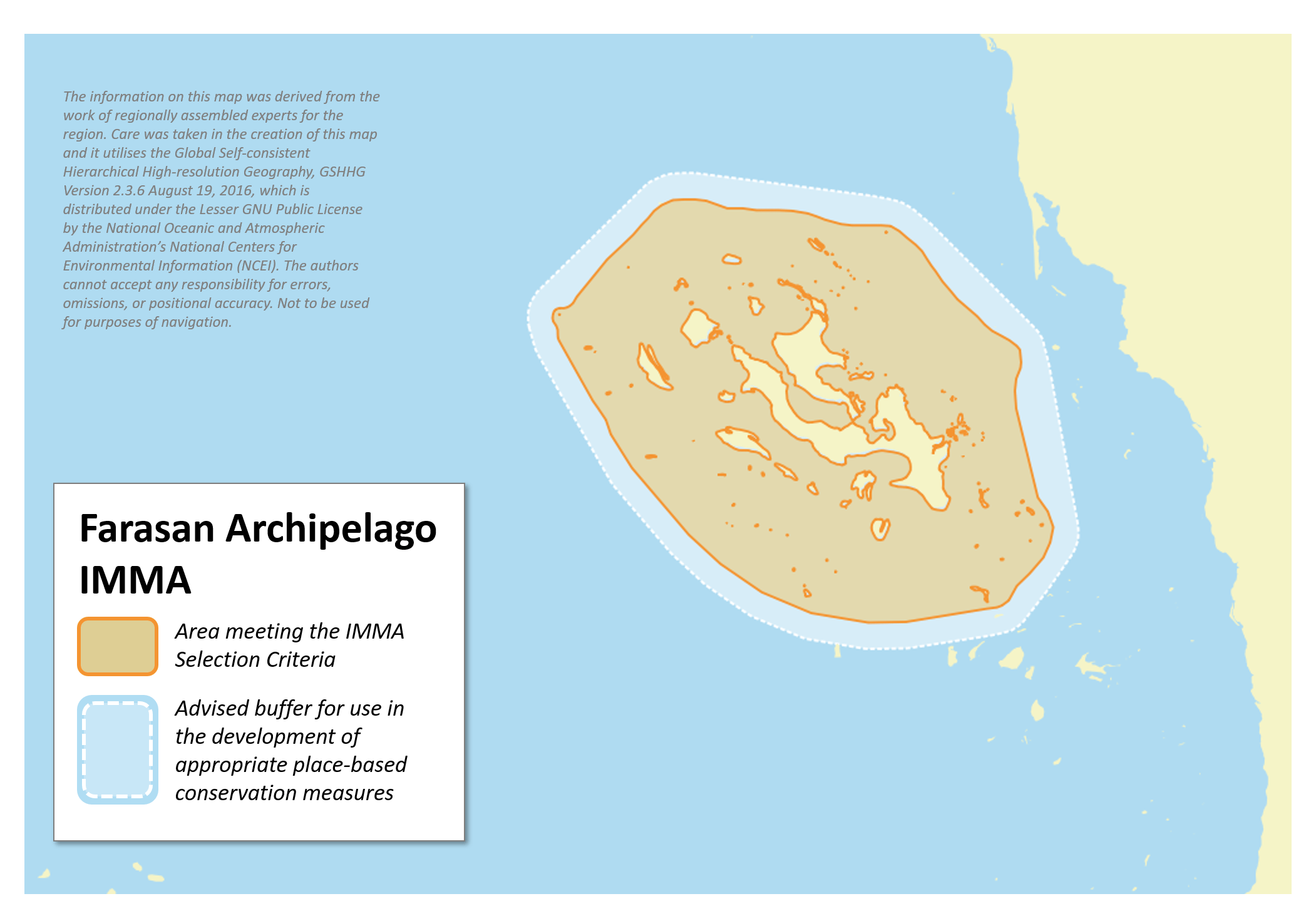Farasan Archipelago IMMA
Size in Square Kilometres
5 889 km2
Qualifying Species and Criteria
Bryde’s whale – Balaenoptera edeni
Criterion C2
Indian Ocean humpback dolphin – Sousa plumbea
Criterion A; C2
Spinner dolphin – Stenella longirostris
Criterion B2
Indo-Pacific bottlenose dolphin – Tursiops aduncus
Criterion C2
Dugong – Dugong dugon
Criterion A; C2
Marine Mammal Diversity
Balaenoptera edeni, Dugong dugon, Orcinus orca, Sousa plumbea, Stenella longirostris, Tursiops aduncus
Download fact sheet
Summary
The Farasan Islands are a large archipelago comprising over 170 islands and islets of uplifted coral reef. The IMMA lies between 40 and 90 km offshore from the city of Jazan on the southeastern Red Sea coast of the Kingdom of Saudi Arabia. A Marine Protected Area covering 5,408 km2 was established around the town of Farasan. This MPA has also been nominated by Saudi Arabia as a tentative UNESCO World Heritage site. The waters of the Farasan Islands support a host of marine mammal species including Endangered Indian Ocean humpback dolphins (Sousa plumbea) and Vulnerable dugongs (Dugong dugon), which feed on the area’s extensive seagrass beds. Bryde’s whales (Balaenoptera edeni), spinner dolphins (Stenella longirostris), and Indo-Pacific bottlenose dolphins (Tursiops aduncus) are also documented in the area.
Description of Qualifying Criteria
Criterion A – Species or Population Vulnerability
Two species within the area listed as threatened in IUCN’s Red List: the Indian Ocean humpback dolphin (EN) (Gladstone & Fisher 2000, Masseti 2010), and the dugong (VU) (Preen 1989, Masseti 2010) consistently occur in the area. Please note that: a) Indian Ocean humpback dolphins where listed in both papers as Sousa chinensis, opposed to Sousa plumbea, because they were published before the species was split; b) bottlenose dolphins are listed as Tursiops truncatus, but the locations where the sightings were made (many of which in very shallow waters) strongly suggests that these must have been Tursiops aduncus, a species the presence of which in the Red Sea seems not to have been known by the authors.
Criterion B: Distribution and Abundance
Sub-criterion B2: Aggregations
The area is noted as providing aggregation opportunities in shallow waters for spinner dolphins, a species known to spend daylight hours within reef shelters to rest after a night spent foraging over open sea slope/deep areas. Given the proximity of steep slopes (about 10 n.m.) to the Farasan Islands, likely to provide appropriate feeding grounds for the dolphins, it can be assumed that the Farasan Islands provide daytime resting aggregation opportunities for spinner dolphins.
Criterion C: Key Life Cycle Activities
Sub-criterion C2: Feeding Areas
Bryde’s whales (Balaenoptera edeni) and Indian Ocean humpback dolphins were observed feeding in the area (Gladstone & Fisher 2000) and dugongs were reported to occur on the extensive seagrass beds in Khawr Ma’di between Farasan Kebir and Segid (Masseti 2010).
Supporting Information
Gladstone W., Fisher P.R. 2000. Status and ecology of cetaceans in the Farasan Islands marine protected area (Red Sea). Fauna of Arabia 18:385-396.
Masseti M. 2010. The mammals of the Farasan archipelago, Saudi Arabia. Turkish Journal of Zoology 34:359-365. doi:10.3906/zoo-0905-2
Notarbartolo di Sciara G., Kerem D., Smeenk C., Rudolph P., Cesario A., Costa M., Elasar M., Feingold D., Fumagalli M., Goffman O., Hadar N., Mebrathu Y.T., Scheinin A. 2017. Cetaceans of the Red Sea. CMS Technical Series 33. 86 p.
Preen, A. (1989). The status and conservation of dugongs in the Arabian Region. MEPA Coastal and Marine Management Series Report, 10, 200 p.


